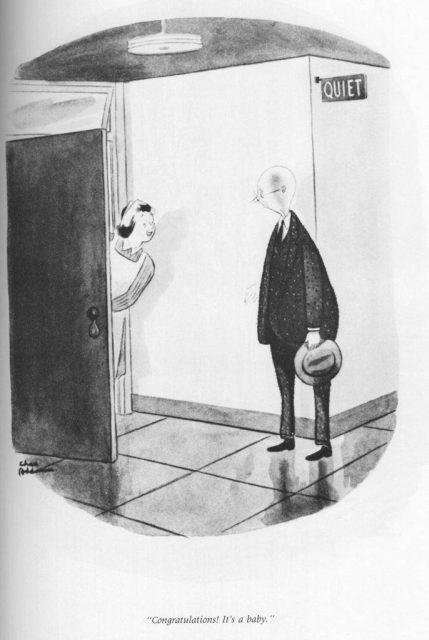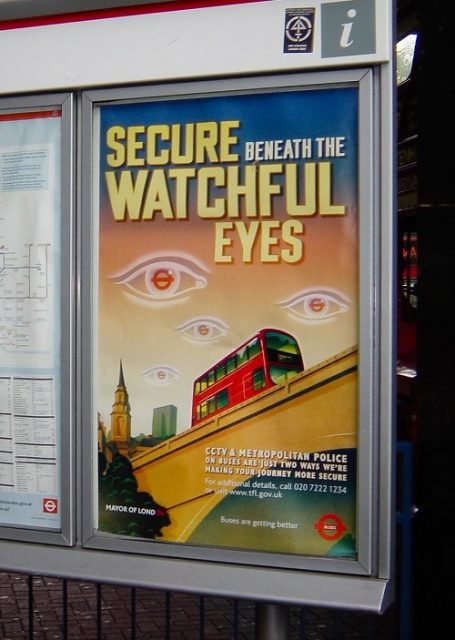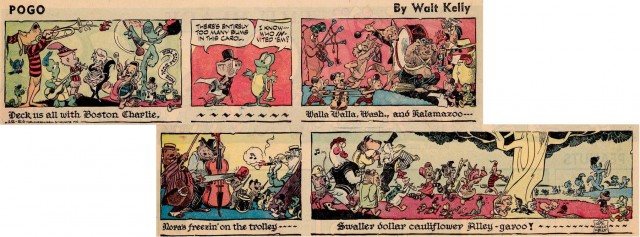How much longer will this be funny? (See item #3.)
Category: Humor and horror
Advisory
If you want to drive me away from your website, pop-ups are among your best strategies. Invoking Facebook makes them even more effective.
Irrelevant update: balletomanes might appreciate today’s Wondermark. Or perhaps not.
Eighty-five years ago today …
Odds and ends

Back in ancient times, synthesizers such as those played by W.W. Carlos and Keith Emerson were assembled from various single-purpose modules, linked together by a multitude of short cables. To change the sound, the musician rearranged the cables and fiddled with the controls on the modules. It was laborious, but with perseverance you could make something like Switched-on Bach or Tarkus. Eventually these modular monsters were replaced by compact synths with fixed architectures, which were easier to program and to transport. Later ones added polyphony and memory for patches, so the musician could play chords and recreate sounds instantly.
Although many of the later synths were immensely useful and desirable, none ever sounded quite like their forebears. Emerson’s modular Moog in particular was legendary. During the past 20 years or so, there’s been increasing interest in modular systems. Notably, the Doepfer “Eurorack” format has become prevalent in certain parts of the electronic music world. A musician can buy whatever modules he wants from a variety of manufacturers and combine them as he pleases. Unfortunately, purchasing modules gets expensive.
However, if you have a reasonably powerful computer, you can run the VCV Rack, a virtual Eurorack. The basic rack, including all you need to make funny noises, is free, and there are many more modules you can download to play with once you get the hang of it, most of which are also free. It’s available here.
I spent several recent lunch hours fiddling with the VCV Rack, and a couple of things quickly became apparent. First, it’s not easy to get an interesting sound out of it. The early synthesists had to work hard to make their music sound good.
Second, videos are the worst way to teach anything. There’s very little text documentation for the rack, so I sat through a number of videos explaining the basics. Good grief, they’re such a waste of time. In principle, videos should be perfect for this job — you can see the connections being made and hear the sounds that result. In practice, you get a guy rambling for half an hour trying to explain something that could have easily been summarized in three minutes. Advice to anyone making an instructional video: before you plug in your microphone, make a detailed written outline of what you want to cover. Better yet, write out what you want to say and skip the video entirely.
*****
Charles G. Hill brings tidings from Japan of a man who “married” a holographic representation of the vocal synthesizer “Hatsune Miku.” Hill linked to a video featuring Miku’s voice which is apparently extremely popular but which doesn’t show what the software is capable of. Here are a couple that better illustrate how a pathetic dweeb could become fixated on the computer-generated image of an anime-style girl: Miku in concert; Miku on a desktop.
Vocal synthesizers, of which Vocaloids are the most successful, occasionally come in handy for those of us with lousy voices. I’ve made use of Miku myself. Others include Plogue’s Alter/Ego and Chipspeech, and Wolfgang Palm’s Phonem.
*****
Francis W. Porretto wonders if anyone remembers Vaughn Meader and David Frye now that their targets are gone. The First Family was before my time, but I do remember hearing one particular skit by Frye frequently at the left end of the FM dial.
*****
It’s been scientifically established that nearly any pop song can be improved by remaking it as a polka or surf tune. In a similar vein, J Greely recently wished that the cast of Dr. Who had turned a recent episode into a Bollywood musical. I haven’t seen that episode so I can’t say for certain, but I expect that would indeed have been an improvement. I suspect, in fact, that most television shows would benefit from being transformed into Bollywood musicals. (Just wondering: are there any Bollywood musical production numbers featuring surf guitar?)
*****
This is terribly unfair, I know, but Cardinal DiNardo in the picture above looks very much like how I visualize Wormtongue when I read The Lord of the Rings.
Pacifist Crush and other silly things
Accumulated miscellaneous nonsense. I forget where I found most of these.
Psittacosis
It’s Squawk Like a Parrot Day. Here are the Bonzos with an appropriate tune.
Addendum: If it’s pirates you want, here’s a set of variations on a tune named for Gráinne Mhaol, alias Grace O’Malley, the Pirate Queen of Ireland.1
Saa! Kaizoku no jikan da! Let’s not forget Marika Kato.
There are many space pirates in anime, and a surprising number of the are women. Their speech sounds like normal Japanese, and none of them gargle their rrrr’s.
Fiddles in snow
Girls und Panzer is on Crunchyroll, and I have the discs as well. However, for the eighth episode I always watch the fansub. One of the highlights of the franchise is the Russian team singing “Katyusha.” Thanks to imbecilic copyright laws, the song is missing from the American edition of the show.1
There are many recordings of the tune available, though none suggest tank girls in snow. I recently discovered that Alexey Igudesman, of Igudesman & Joo, composed a set of variations on “Katyusha” for solo violin. Here’s a performance by Irina Pak.
Not familiar with Igudesman & Joo? Here’s an introduction. If you don’t have time for the whole thing, skip to the Rachmaninoff section starting at around 40 minutes. There’s plenty more on YouTube.
Before there were I&J, there was P.D.Q. Bach. Peter Schickele is still making discoveries, such as the Concerto for Simply Grand Piano and Orchestra.2 Here’s a performance with Jeffrey Biegel. While Biegel is certainly up to the technical demands, he’s not quite enough of a large ham to make the performance convincing. Perhaps with a bushy beard and another 50 pounds he could pull it off.
Hens on the Danube
There’s been a dearth of chickens around here lately. We’ll have to do something about that.
Anthropogenic pitch change is real.
Real or not?
It’s hard to tell. The screencaps above I believe are genuine, but the pictures below might be fake. Then, again, perhaps London really is turning into an updated suburb of Scarfolk. In either case, it would be difficult to top these, and I haven’t had the time to work anything up.
Posts from previous years appropriate to the first day of the fourth month are archived here.
(I’m posting this a day early because tomorrow is Easter.)
By the co-author of Gyűrűkúra
Since you can’t do much gardening outdoors in February, you might as well read some books. One I regularly consult is Henry Beard‘s Gardening: A Gardener’s Dictionary, illustrated by Roy McKie. Beard may be familiar as the author of such works as Latin for All Occasions and Zen for Cats. Those with long memories might remember him as the most reliably funny writer at National Lampoon and as one of the scholars responsible for the volume variously known as Nuda Pierścieni, Loru sorbusten herrasta, or Bored of the Rings. He’s also an expert on bad golf.
Gardening has been out of print for years, but used copies are available for reasonable prices. Here are a few of the definitions.
Yard
1. (penology) dusty open area where hard labor is performed. 2. (horticulture) dusty open area where hard labor is performed.
Vermiculite
Obscure order of nuns dedicated to gardening. Like other devotional orders, the sisters take the traditional vows of chastity, poverty, and obedience, but in keeping with the demanding nature of their calling, the Vermiculites are the only such group with a special dispensation to drink, smoke, swear, and throw things.
Rot
Gardening advice.
Pest
Any creature that eats green vegetables without being compelled to.
Narcissus
Wonderful, early-blooming flower with an unsatisfactory plural form. Botanists have been searching for a suitable ending for years but their attempts — narcissi (1947), narcissusses (1954), narcissus for both singular and plural (1958) and multinarcissus and polynarcissus (1962, 1963) — haven’t enjoyed any real acceptance, and thus, gardeners still prefer to plant the easily pluralized daffodil or jonquil.
Jack-in-the-Pulpit
The state flower of Maryland. Shortly after being named, the designation was challenged by atheist groups who sued to have it removed on the constitutional grounds that its selection promoted religion. In a compromise that appears to have pleased no one, the plant was retained but officially renamed “Fred-in-a-phone-booth.”
Hose
Crude, but effective and totally safe type of scythe towed through gardens to flatten flower beds and level vegetable plantings.
Grape
Uninteresting larval stage of wine.
Garden
One of a vast number of free outdoor restaurants operated by charity-minded amateurs in a effort to provide healthful, balanced meals for insects, birds, and animals.
Fence
Wire barrier erected to protect garden produce against animal pests that lack wings, paws, teeth, or brains, and cannot leap, tunnel, climb, or fly.
Brochures and Catalogs
Forms of entertaining fiction published by nurseries, seedsmen, and tool manufacturers.
Bluegrass
Rare lawn condition in which normally brown, crisp lawns develop odd patches of a sort of hazy green growth. Don’t be alarmed! These strangely colored areas usually disappear within a few weeks.
Autumn
Delightful season that runs from the disposal of the last zucchini to the arrival of the first catalog.
Too much culture
Here’s a month’s accumulation of video timewasters.
One of my Christmas gifts was Eight Days a Week, an account of the early years of that band from Liverpool. It reminded me of the story of a certain other band. Bonus: Neil Innes vs. the Beatles.
A biography of one of the great British eccentrics. (Here’s an uninterrupted performance of one of the musical numbers.)
For those with certain, um, unusual tastes, here’s a documentary on the Shmenge Brothers.
It looks like Batman Ninja will be, at the very least, a good-looking movie, but what interests me is the writer, one Kazuki Nakashima.
And now for some high culture:
And finally, the only version I can tolerate of a certain overly-popular baroque piece, performed by the idiosyncratic Jun Togawa.1
Someday …
Keep your wrist solid and in alignment with the bones of your forearm
A couple of links to help you get into the spirit of the season:
• What to give the heretic on your list (See also St. Louis’ guide to dealing with barbarians.)
• Beware rogue carolers, and avoid broadcast media until December 24
If you absolutely must sing a carol, here are the words:
Sensitive types, beware
What’s so potentially offensive that Twitter places a warning label on it?
(Via Dustbury.)
Greetings from East Feffy Foofy
A long time ago, back before the last ice age, I came across a short piece called something like “In Space with Runyon Jones” in a collection of science fiction stories. It was a series of vignettes in which the young Jones encounters a variety of aliens while traveling in spaceships, which the editor of the anthology had gleaned from a novel by Norman Corwin. I was curious to read the rest of the book, but it was long out of print by then, and has never been reprinted. I never found it in any library or used book store.
A few years ago, I remembered the story and thought that perhaps it might be possible to locate a copy of the book online. While searching, I found that Corwin’s story had first been a radio play, “Odyssey of Runyon Jones,” broadcast in 1941. It’s available here. Once you accustom your ears to the low-fidelity sound, it’s entertaining listening. Runyon’s dog Pootzy has been hit by a car and killed, and Runyon wants him back. He braves bureaucracy, meets Father Time and Mother Nature, and eventually finds his way to Curgatory and a trick ending.
Ten years later, Corwin turned the radio play into the novel Dog in the Sky, of which I eventually located an affordable copy. In addition to expanding the episodes in the play, he introduced a sub-plot involving a Mr. B.L.Z. Bubb, a bureaucrat very interested in Runyon’s quest, and adds details of Runyon’s adventures as he travels from planet to planet. The Bubb business is never very interesting and it eventually fizzles out, but the aliens Runyon meets are what caught my attention in the excerpts I read years ago, and are what might make the book worth reprinting someday. There are quite a variety of them, including an interplanetary perfume salesman, a lonely robot, a very important businessman from Venus, and a spooky cat/woman. And a certain 62Kru:
62Kru returned to his monologue as though nothing had happened. “Love is science. Science is love. That is all the protons and isotopes know, and all they need to know. The beta ray hankers for the gamma, both are enamored of the delta, and all in turn adore the lambda.
You see, friend, we Hankerites deplore the fact that the galaxies are rushing away from each other. This is because of a misunderstanding which occurred some billions of years ago. We aim to rectify, restore and reunite the estranged universe, to bind all together under the harmonious love of the true Hruh, whose throne is everywhere and anywhere. Blasphemers and atheists have tried to prove that Hruh is really nothing but
but the true Hankerite is unshakable in his faith, resolute in his virtue, confident in the supremacy and inviolability of love, and we have already killed several million disbelievers to prove this.
*****
Something else I stumbled across at Archive.org: the A.M. Yankovic/W. Carlos version of “Peter and the Wolf.” It’s not the best example of either’s work, but it has its moments. The recording is probably still under copyright, so it may disappear from the site at any moment.
(My favorite version is the that by the Royal Ballet School, with Anthony Dowell as narrator and Grandfather. It starts here.)
Stopping by for a moment
I’m alive again after an unpleasant two weeks. I’ve got a lot of cleaning and catching up to do, so I’ll continue to be scarce here.
*****
A few things that caught my eye or ear recently:
I have a little list of words and phrases that tell me everything I need to know about the people who use them. So does J Greely.
Science, Roger Bacon and Robert Grosseteste.
Are the New York Disco Villains the Bonzo Dog Band reborn? (Via the Professor.)
Mozart and Chagall.
The Magic Flute – Chagall Animation from 59 Productions on Vimeo.
Mozart and Tonari no Seki-kun. (Via Wonderduck.)
There’s a live-action version of Tonari no Seki-kun. You don’t need to know Japanese to follow the story.
Bonus link: Vulcanologist Erik Klemetti counts down his list of the ten most dangerous volcanoes. If you’re thinking of investing in European real estate, forget Naples.















